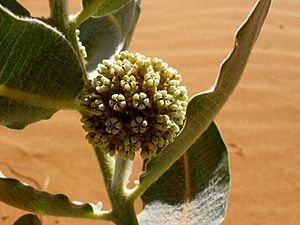Welsh's milkweed facts for kids
Quick facts for kids Welsh's milkweed |
|
|---|---|
 |
|
| Conservation status | |
| Scientific classification | |
| Genus: |
Asclepias
|
| Species: |
welshii
|
Asclepias welshii is a very special and rare plant. It is a type of milkweed known as Welsh's milkweed. This plant grows in the sandy areas of southern Utah and northern Arizona. It is a threatened species in the United States, meaning it needs protection to survive.
What is Welsh's Milkweed?
This plant is a perennial herb, which means it lives for many years. It can grow up to one meter (about 3 feet) tall. Scientists who described the plant in 1979 called it "a rather handsome milkweed." They also noted it is very unique and does not have any obvious close relatives.
How Does it Grow?
Welsh's milkweed grows from a strong underground system called a rhizome. This rhizome helps the plant stay anchored in the shifting sands of its dune home. Several stems can grow above ground from just one rhizome system. This makes it hard to count how many individual plants there are. Many stems might actually belong to one large plant!
The rhizomes can go very deep into the sand, possibly even reaching the bedrock below. All the plants in one area might even be clones from a single original plant. Experts estimate there are about 20,000 stems. But the number of truly separate plants is unknown.
This milkweed is a "pioneer species." This means it is one of the first plants to grow in empty dunes. Over time, other plants may move in and compete with it. It often grows in sandy areas called blowouts. Here, it can be found next to blowout grass (Redfieldia flexuosa).
Plant Features
The upright stem of Welsh's milkweed has pairs of leaves. These leaves can be up to 9 centimeters (about 3.5 inches) long and 6 centimeters (about 2.4 inches) wide. Both the stem and leaves are covered in thick, woolly hairs. These hairs are especially noticeable on new leaves. The hairs might help the plant save water in its dry home. They may also protect the plant from sand blown by the wind.
The plant produces a dense, round cluster of many flowers. This whole flower head can be about 7 centimeters (about 2.8 inches) wide. Each flower is small, less than a centimeter long. They are white with a pale pink center.
After flowering, the plant produces a warty fruit called a follicle. Inside are large seeds with tufts of hair. These seeds are at least 2 centimeters (about 0.8 inches) long. Many plants do not produce many mature fruits. Instead, they spread by vegetative reproduction. This means they grow new plants from their rhizomes.
Young Welsh's milkweed plants can look very different from mature ones. This can make them hard to identify. The smallest plants have narrow, thin leaves. The next stage of growth has leaves that are in between the small and mature forms.
Where Does it Live?
The largest group of Welsh's milkweed plants is found in Coral Pink Sand Dunes State Park. Part of this area is managed by the Bureau of Land Management. This part has been affected by off-road vehicle (ORV) use. However, ORV activity has not increased since the plant became protected. Park staff keep track of ORV use in the area.
ORVs are not allowed in the Paria Canyon-Vermilion Cliffs Wilderness. A large group of these plants also lives there. The plant also grows south of Utah, in Arizona. This group is on Navajo Nation land. This area is remote and not regularly watched. It is not thought to be affected by human activities.


